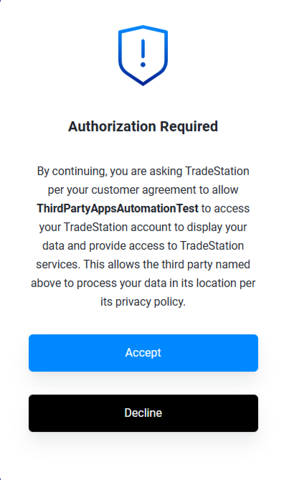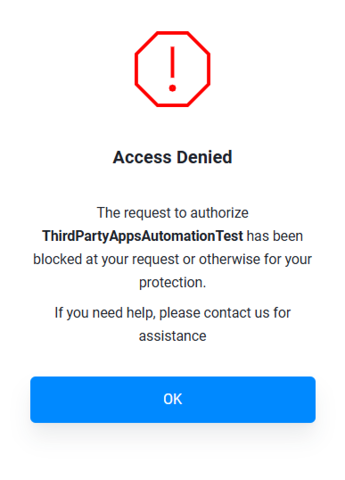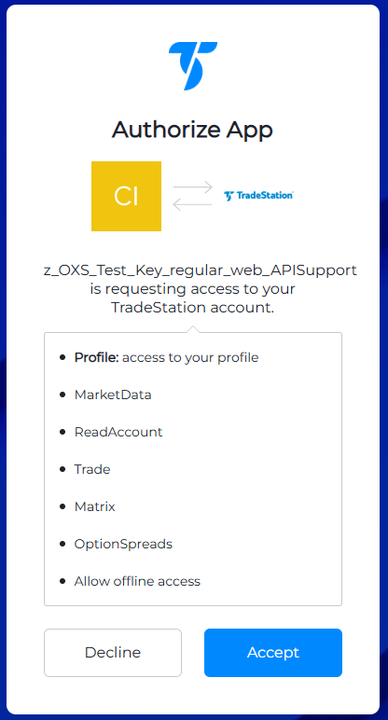Auth Code Flow
The authentication procedures detailed in this documentation are for Auth0 API keys. For more information on API keys and formats, click here.
Authorization Code Grant Flow
The authorization code grant type is used to obtain both Access Tokens and Refresh Tokens and is optimized for confidential clients. Since this is a redirection-based flow, the client must be capable of interacting with the resource owner’s user-agent (typically a web browser) and capable of receiving incoming requests (via redirection) from the authorization server.
Implementation Guide
The authorization code grant type allows the end users to authenticate with TradeStation directly and authorize the Client application to make calls on their behalf. Access tokens expire 20 minutes from the time they are issued.
Step-by-Step
1. Redirect user for authentication/authorization
The client application will route the end-user to our authorization URL:
https://signin.tradestation.com/authorize
Query string parameters:
| Parameter | Required/Optional | Value |
|---|---|---|
response_type | required | Set this to code. |
client_id | required | The client application’s API Key. |
audience | required | Set this to https://api.tradestation.com. |
redirect_uri | required | The redirect_uri of your application. This must be included in the list of Callback URLs that your API Key is configured with (contact Client Experience if you need to add your URL). Allowed Callback URLs are:
|
scope | required | A space-separated list of scopes (case sensitive). openid scope is always required. offline_access is required for Refresh Tokens. Example: openid profile offline_access MarketData ReadAccount Trade. See Scopes for more information. |
state | recommended | An opaque arbitrary alphanumeric string value included in the initial request that we include when redirecting back to your app. This can be used to prevent cross-site request forgery attacks. |
Example Authorization URL:
The URL is shown on multiple lines for readability, but must be entered in a browser as a single unbroken line.
https://signin.tradestation.com/authorize?
response_type=code&
client_id=YOUR_CLIENT_ID&
redirect_uri=http://localhost:8080&
audience=https://api.tradestation.com&
state=STATE&
scope=openid offline_access profile MarketData ReadAccount Trade Matrix OptionSpreads
The URL will take you to a TradeStation login page.
2. Client logs in with TradeStation credentials (TradeStation username and password)
Upon logging in with TradeStation credentials, a dialog is presented for the user to allow or not allow the application to make API requests on their behalf. This dialog will be displayed each time the client logs in.
If a localhost redirect_uri is used (e.g., http://localhost, http://localhost:3000), you may see a 2nd consent dialog if it is the first login or access was previously denied. Once consent is approved with this dialog, it will not be displayed again with subsequent logins (API key/login combination) unless the requested scopes are different.
Consent dialog displayed when logging in regardless of redirect_uri:

APPROVED. If authorization is granted, authorization will proceed and the authorization code is returned as part of the redirect_uri (see below).
DECLINED. If authorization is declined, a dialog is displayed:

When the user clicks “OK” on the dialog, the request is directed back to the redirect_uri with the following error in the browser address bar.
http://example.com/?error=access_denied&error_description=User%20declined%20authorization
As noted above, a 2nd authorization dialog may appear when using a localhost redirect_uri:

ACCEPT. If authorization is granted, authorization will proceed and the authorization code is returned as part of the redirect_uri (see below).
DECLINE. If authorization is declined, the request is directed back to the redirect_uri with the following error in the browser address bar:
http://localhost:8080/?error=access_denied&error_description=User%20did%20not%20authorize%20the%20request
If the user authorizes the application to make API requests on their behalf, continue following the steps below.
3. Client receives Authorization Code
Upon successful authentication, the user agent (browser) will be redirected to the URL provided, which will include an Authorization Code in the query string.
The number of characters in the Authorization Code is variable (not fixed-length).
Example Redirect:
HTTP/1.1 302 Found
Location: http://localhost:8080?code=AUTHORIZATION_CODE&state=xyzABC123
4. Exchange Authorization Code for Access Token, ID Token and Refresh Token
The client uses the Authorization Code to request an Access Token, ID Token and Refresh Token via the
/oauth/token endpoint using the authorization_code grant type.
The number of characters in the Access Token is variable (not fixed-length).
This exchange is done via a POST request and the content-type header should be set to application/x-www-form-urlencoded.
Token URL:
https://signin.tradestation.com/oauth/token
Parameters:
| Parameter | Required/Optional | Value |
|---|---|---|
grant_type | required | Set this to authorization_code. |
client_id | required | The client application’s API Key. |
client_secret | required | The secret for the client application’s API Key. |
code | required | authorization_code from the previous step. |
redirect_uri | required | The redirect_uri of your app. |
Example Request:
curl --request POST \
--url 'https://signin.tradestation.com/oauth/token' \
--header 'content-type: application/x-www-form-urlencoded' \
--data 'grant_type=authorization_code' \
--data 'client_id=YOUR_CLIENT_ID' \
--data 'client_secret=YOUR_CLIENT_SECRET' \
--data 'code=YOUR_AUTHORIZATION_CODE' \
--data 'redirect_uri=http://localhost:8080'
Example Response:
{
"access_token": "eGlhc2xv...MHJMaA",
"refresh_token": "eGlhc2xv...wGVFPQ",
"id_token": "vozT2Ix...wGVFPQ",
"token_type": "Bearer",
"scope": "openid profile MarketData ReadAccount Trade offline_access",
"expires_in": 1200
}
ID tokens are used in token-based authentication to cache user profile information and provide it to a client application, thereby providing better performance and experience. The application receives an ID Token after a user successfully authenticates, then consumes the ID token and extracts user information from it, which it can then use to personalize the user's experience. ID Tokens are JSON web tokens (JWT) that will need to be decoded in order to extract the user information for use in your application. Please see the Other Relevant Scopes Table on the Scopes page to learn more about configuring the ID Token.
Access Tokens are set to expire after 20 minutes. Please visit the Refresh Tokens page to learn about using Refresh Tokens to renew your Access Token.